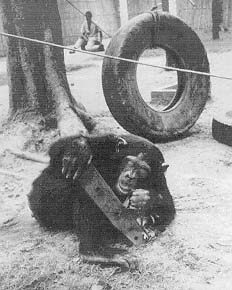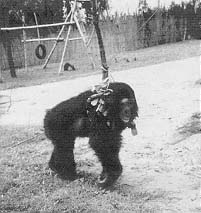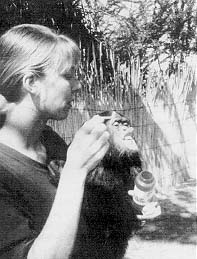Jennifer Lindsey, Editor
At the Jane Goodall Institute Halfway House in Burundi 18 orphaned chimpanzees live in a one-acre yard near the shores of Lake Tanganyika, awaiting a new home in a sanctuary that has yet to be built.
Ethnic problems in the small African country, coupled with a shortage of funds for all of the institutes' projects, have put plans for the 4-hectare semi-natural sanctuary on indefinite hold.

Intended only as a temporary holding facility for five chimpanzees, the halfway house is now bursting at the seams and continuing to fill as more orphans are confiscated around the country from poachers, hotel and restaurant owners, or private citizens who keep them as pets.
Meanwhile, the orphaned chimpanzees, aged 2.5 to 12 are given constant attention, nurturing, and care by two professional directors, 12 local staff, and volunteers from around the world.
This article will illustrate how, through innovation and creativity, the workers at the institute are able to provide low-cost environmental enrichment on a daily basis using only donated and recycled materials.
Background
The Halfway House was created in 1991 as a temporary holding facility for orphaned captive chimpanzees who were taken illegally out of the forests of Burundi and Zaire by poachers. Working in cooperation with the Burundian government, the Jane Goodall Institute confiscates the young chimpanzees from the poachers, street vendors, or ignorant owners and takes them to the halfway house where they can be nursed back to health and resocialized for eventual release into a sanctuary.
The proposed sanctuary, which would encompass 4 hectares of bushland on the shores of Lake Tanganyika in the southern part of the Burundi, was scheduled to be finished in 1993. But with no funds and an uncertain political situation in the host country, the project has yet to begin.
Built to house only five chimpanzees on a temporary basis, the Halfway House is now home to 18, all dependent on the Jane Goodall Institute to provide them with an enriching and caring environment in which to grow up and live out their lives. Studies have shown that orphaned chimpanzees taken from the forests at an early age are unable to return to the wild because they are too accustomed to human care and contact and lack the basic skills needed to survive; skills they would have learned from their mothers (Science, Vol. 265).
Of the 18 chimpanzees, the youngest four, aged 2.5 to 4, run free throughout the yard during the day and spend the night on the terrace of the directors' and volunteer's house. Four older chimps, aged 5-7, are kept on long lightweight chains attached to tethers stretched across the yard. They can still run, climb trees, and interact with the other chimps, but are restricted from climbing over the fence. These four sleep in a cage in the back of the yard. The oldest 10 chimps, aged 7 to 13, are kept in a large caged structure divided into six sections for shifting and cage cleaning.
Daily Enrichment
In addition to daily food preparation, distribution, and cage cleaning duties, one worker (director, manager, or volunteer) each day is assigned the duty of providing environmental enrichment.
Supplies, piled in a large box in the dining room, include old socks, discarded clothes, toilet paper rolls, old plastic plates , and small cardboard boxes (e.g., for packaging of medicine bottles, toothpaste, film canisters, etc.). Many of the supplies are donated by local expatriates made aware of the institute's need through newspaper notices and word of mouth.
Every enrichment activity is recorded in a daily ledger, along with the chimpanzees' general reaction. No scientific data is collected on time spent by the chimpanzees on each activity.
Following is a description of seven enrichment activities used at the center during a one-week period, chosen randomly from the general ledger.
Day 1: Small cardboard packages filled with peanuts in the shell. The boxes must be fully intact so the lid can be closed, requiring the chimpanzees to first open the box before they reach the peanuts. The youngest chimps spent more time on the activity than the young adults in the cages. While the young ones would take the closed box into a tree or in a comer of the yard to open the box and the peanuts at their leisure, the older chimps tore the boxes open with their teeth and scurried to collect the peanuts that fell to the ground. Empty toilet paper and paper towel rolls can also be used, closed at the ends with masking tape.
Day 2: Honey and peanut butter smeared on tires, trees, and cage bars. Before the eight young chimpanzees were released into the yard in the morning, a mixture of honey and peanut butter was smeared on the jungle gyms, on low tree limbs, and the inside of washed tires. Coated tires were placed in the cages and cage bars were also smeared during the morning shifting process for the older chimpanzees. This was a well-liked enrichment activity for all the chimpanzees. Once they discovered the treats, the young ones emitted loud food grunts as they ran through the yard looking for more.
Day 3: Browse from the nearby forest. The director of the center who also worked in the Kibira forest in the northern part of Burundi brought banana tree branches and other vegetation for snacking and nest building. All the chimps, whether in the yard or in the cage, spent long periods of time gathering the browse around and under them on the ground and on tires to simulate nest building. Leftover browse were placed in the young chimps' sleeping quarters for night nests. (See photo.)

Day 4: Dipping blocks. For the eight yard chimps, one-quarter inch holes were drilled into wooden blocks and filled with a mixture of honey and smashed bananas. The chimpanzees used twigs from the yard to retrieve the treats from the holes. PVC tubing filled with a honey and bananas mixture was stuffed into the ground outside the cage for the older chimps and they were given long sticks and limbs to fish for the treats.
Day 5: Flavored ice blocks. A flavored drink mix was frozen in a large bowl with a lightweight chain (approx. 5 ft. long) frozen in the middle. Once hardened, the chain was surrounded by a PVC tube, for safety, and suspended from a tree limb in the middle of the yard. Caged chimps were each given a small flavored ice block frozen in regular serving bowls. The ice blocks were kept in the freezer to be used on exceptionally hot days.
Day 6: Fruit hidden in containers. Bananas, passion fruit, and oranges were hidden in old baby formula containers with flat, inverted lids (similar to NestleQuick containers). The chimpanzees used sticks and flat rocks to force the lids off the containers to retrieve the fruit.
Day 7: Cardboard boxes and scraps. Old boxes donated by the community and cardboard scraps from a local cardboard company were given to the chimps to do with as they pleased. The chimps sat in the boxes, carried them around the yard and into the tree, and tore them apart. The cardboard scraps were used to build artificial nests and as sponges, similar to the wild chimpanzee practice of using chewed leaves to sponge water from hard to-reach water holes. (Goodall, 1986)
Other
Other low-cost enrichment activities used at the center include:
- tennis balls and basketballs
- fruit or peanuts tied in old socks
- bananas smeared between the pages of old magazines
- plastic trash lids smeared with honey and peanuts
- bubble-blowing mixtures (see photo, page 3)

In the Yard
In addition to the daily activities, the yard was filled with various permanent structures to promote play and exercise:
- two jungle gyms made with bamboo poles, rope, and wire.
- tires hanging from branches using PVC tubing and rope.
- a plastic bathtub, located in the middle of the yard, filled with fresh water (used for splashing and food washing).
- a wicker basket suspended from a tree using lightweight chains and PVC tubing.
Discussion
Of the enrichment activities discussed above, only the following items were purchased by the center: food stuff (honey, peanuts, bananas, fruit, flavored drinks); the one-time cost of tubing, wire, rope, and chains for hanging and building; and the one-time cost of lumber for the wood blocks with holes. All other items were donated by area residents or found in and around the complex.
Conclusion
Although the necessity for enrichment activities for all captive primates is well documented and need not be argued again, there are still those in the research community who view enrichment as a burden to laboratory personnel and an unnecessary expense on already-tight budgets. The purpose of this article has been to illustrate how recycled, throwaway, and donated materials can be used creatively at little to no cost for the daily enrichment of chimpanzees.
References
Goodall, J. (1986). The Chimpanzees of Gombe: Patterns of Behavior, Cambridge, MA: Harvard University Press.
Science, Vol. 265, 15 July 1994, p. 312.
IN TOUCH Summer 1994 Volume 1, No. 3
This article was reproduced with permission of the publisher.